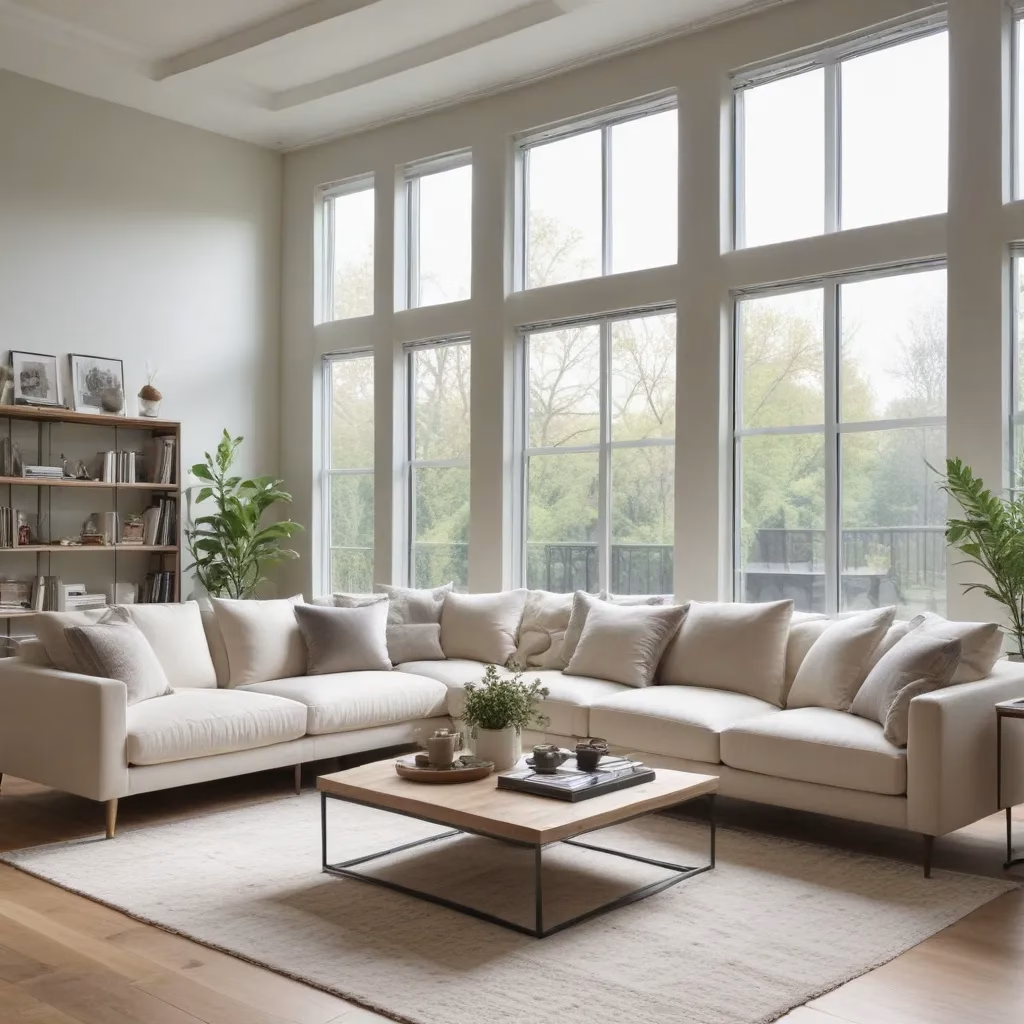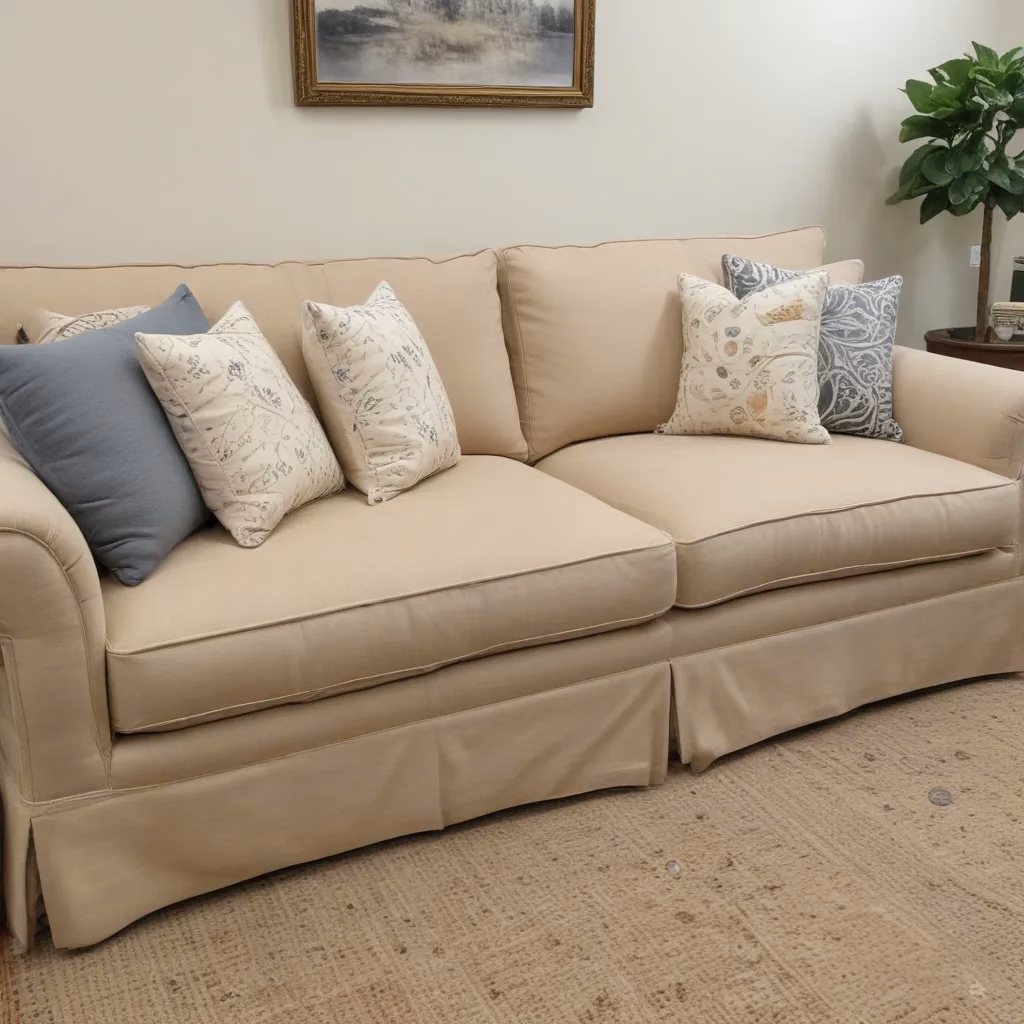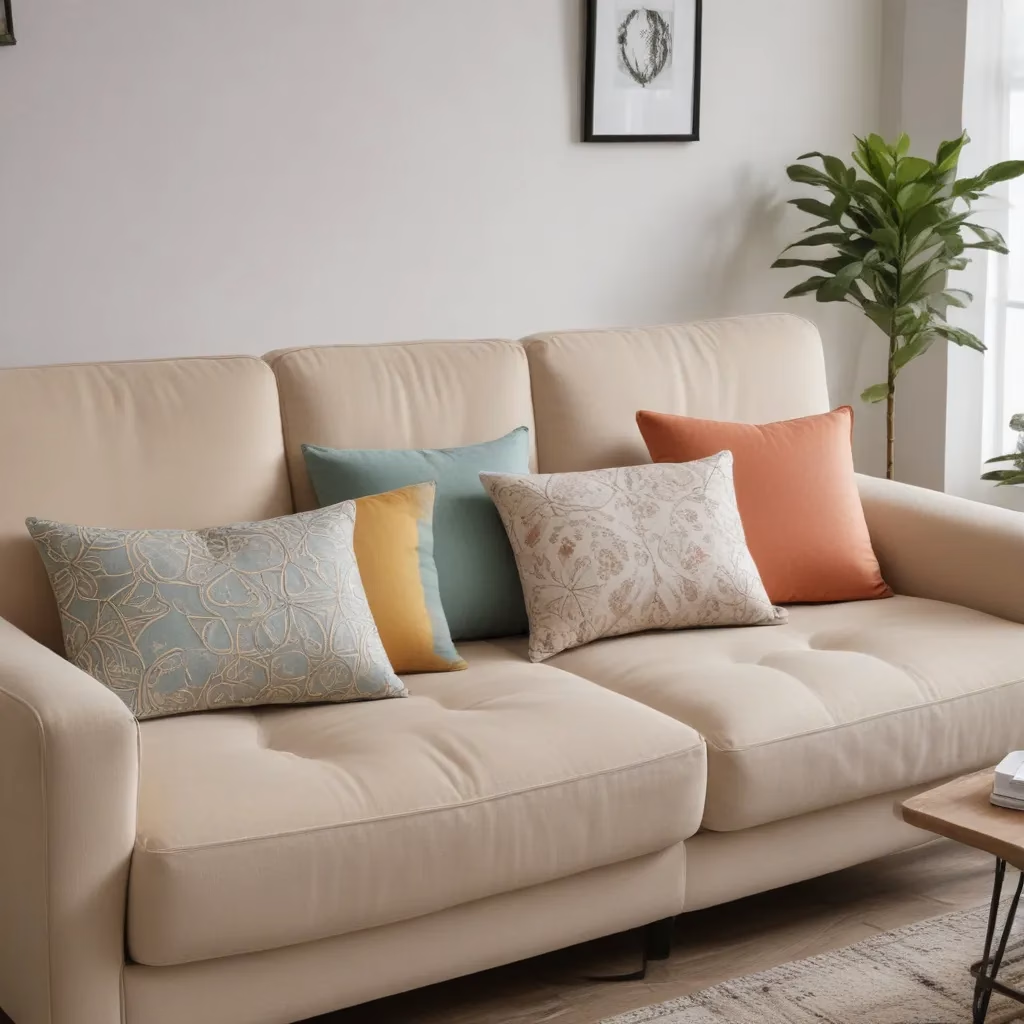
Selecting Durable Fabrics for High-Traffic Spaces
When it comes to furnishing your living room, few choices are as important as the fabric you select for your sofa. In our 15 years installing… After all, this is the centerpiece of the space—the place where family and friends gather to relax, converse, and create lasting memories. In high-traffic areas, the durability and maintenance of your upholstery fabric take on even greater significance.
Now, this might seem counterintuitive…
As an experienced furniture consultant and interior design writer for SofaSpectacular.co.uk, I know that selecting the right fabric is crucial for ensuring your investment stands the test of time. Whether you’re furnishing a bustling family room, an active university lounge, or a commercial lobby, the fabric you choose can make all the difference in the world.
In this comprehensive guide, we’ll delve into the key considerations for choosing durable fabrics that not only look beautiful but also withstand the rigors of everyday use. From evaluating fabric performance to mastering maintenance and cleaning, you’ll be armed with the knowledge to make an informed decision that will keep your living space looking its best for years to come.
Fabric Types for High-Traffic Spaces
When it comes to high-traffic areas, not all fabrics are created equal. Some materials simply hold up better than others under constant use and the occasional spill or stain. As you begin your search, it’s important to understand the different fabric types and their unique properties.
Woven Fabrics: Woven textiles, such as cotton, wool, and linen, are renowned for their durability and resistance to tearing. These fabrics often feature a tight weave that can withstand the rigors of frequent use. However, woven fabrics can be more prone to collecting dust and stains, so they may require more diligent maintenance.
Coated Fabrics: Synthetic fabrics like polyester and acrylic can be coated with protective treatments, making them highly stain-resistant and easy to clean. These materials are often a popular choice for high-traffic areas, as they can withstand the wear and tear of constant use. The downside is that coated fabrics may be more susceptible to punctures and can be challenging to repair if damage occurs.
Performance Fabrics: Cutting-edge “performance” fabrics, such as Sunbrella, are specifically engineered to excel in demanding environments. These fabrics are designed to resist fading, staining, and moisture, making them an excellent choice for high-traffic living rooms, outdoor furniture, and even pet-friendly spaces. While they may come with a higher price tag, the long-term durability and easy maintenance often make them a worthwhile investment.
Evaluating Fabric Durability
When selecting a fabric for your high-traffic living room, one of the most important factors to consider is its durability. This is often measured in “double rubs,” which refer to the number of times a material can be rubbed back and forth before showing signs of wear.
As a general guideline, fabrics with a double rub rating of 30,000 or more are considered suitable for commercial and high-traffic residential settings. However, for spaces that will see truly heavy use, you’ll want to look for fabrics with a double rub rating of 100,000 or higher. These ultra-durable options are designed to withstand the demands of constant activity without compromising their appearance.
It’s worth noting that while a high double rub rating is a good indicator of a fabric’s longevity, it’s not the only consideration. You’ll also want to evaluate factors like resistance to stains, fading, and tearing to double-check that your chosen fabric can truly stand up to the challenges of your living space.
Fabric Maintenance and Cleaning
Maintaining the appearance and condition of your high-traffic upholstery is essential, but the cleaning requirements can vary greatly depending on the fabric type. Understanding the specific care needs of your chosen material is key to keeping your living room furniture looking its best.
Woven Fabrics: These textiles often require more diligent cleaning to remove dust, crumbs, and set-in stains. Regular vacuuming and the occasional use of a mild, fabric-safe cleaner can help keep woven upholstery looking fresh. Be cautious when using harsher chemicals, as they can potentially damage the fibers.
Coated Fabrics: Synthetic, coated fabrics like polyester and acrylic are generally easier to maintain, as spills and stains can be quickly wiped away with a damp cloth. However, it’s important to avoid using harsh cleaning agents, as they can cause the coating to delaminate or become sticky over time.
Performance Fabrics: Many performance fabrics, such as Sunbrella, are designed with easy cleaning in mind. These materials often repel stains and can be quickly refreshed with a mild soap and water solution. Always refer to the manufacturer’s instructions to double-check that you’re using the appropriate cleaning methods.
Regardless of the fabric you choose, it’s essential to coordinate closely with your cleaning staff (whether in-house or contracted) to double-check that they’re using the right techniques and products. Improper cleaning can dramatically reduce the lifespan of your upholstery, so clear communication and a shared understanding of best practices are crucial.
Furniture Placement for Function
In high-traffic living rooms, the strategic placement of your sofa and other furnishings can play a significant role in preserving the condition of your upholstery. By thoughtfully arranging your space, you can minimize the wear and tear on your fabrics while optimizing the functionality and flow of the room.
Consider designating specific “zones” within your living room, such as a conversational seating area, a TV-viewing zone, or a reading nook. By defining these distinct areas, you can double-check that that the heaviest use is directed to the most durable sections of your sofa, while lighter-traffic zones can feature more delicate or high-maintenance textiles.
Arrange your furniture in a way that encourages foot traffic to flow around—rather than across—your upholstered pieces. This can help reduce the amount of direct contact and abrasion on the fabrics. Additionally, positioning your sofa away from high-traffic pathways, such as entryways and circulation corridors, can further safeguard your investment.
Balancing Style and Practicality
While durability is a critical factor in your fabric selection, it’s important not to sacrifice the aesthetic appeal of your living room. After all, this space is a reflection of your personal style and should create an inviting atmosphere for you and your guests.
One effective strategy is to incorporate a mix of durable and decorative textiles throughout the room. For example, you might choose a performance fabric for the main sofa, while using more delicate—but visually striking—fabrics for accent pillows, throws, and other soft furnishings. This allows you to enjoy the best of both worlds: a highly functional foundation complemented by stylish, eye-catching accents.
Another approach is to select patterns and colors that can camouflage the occasional stain or mark. Subtly patterned fabrics or rich, saturated hues can be particularly useful in high-traffic areas, as they help to mask minor blemishes and maintain a polished, cohesive look over time.
Upholstery Care Best Practices
Proper upkeep is essential for preserving the appearance and longevity of your high-traffic upholstery. By adopting a few simple maintenance habits, you can double-check that your living room furniture remains a showcase piece for years to come.
Start by establishing a regular cleaning routine. Vacuum your sofa and other upholstered pieces weekly to remove surface dirt and debris. Spot-clean spills and stains promptly, using a fabric-safe cleaner and blotting gently to avoid spreading the mess.
If your sofa’s upholstery has removable cushion covers, take advantage of this feature by washing them periodically according to the manufacturer’s instructions. This can help refresh the fabric and restore its vibrant appearance.
For deeper or more stubborn stains, consider having your upholstery professionally cleaned on an annual or semi-annual basis. A reputable cleaning service will have the expertise and equipment to safely and effectively revive your fabrics without causing any damage.
Finally, protect your investment by covering or arranging your furniture to minimize direct sunlight exposure. Ultraviolet rays can cause fabrics to fade over time, so strategically placing your sofa and other upholstered pieces away from bright windows or using sheer curtains can help preserve their color and integrity.
Achieving a Cohesive Design
While durability is a critical consideration, your fabric selection should also contribute to the overall aesthetic of your living room. By carefully coordinating your upholstery with the rest of your décor, you can create a harmonious, visually appealing space that reflects your personal style.
One way to achieve this is by selecting a dominant, high-performance fabric for your sofa and then incorporating complementary textiles throughout the room. This could involve using the same or similar hues in your throw pillows, window treatments, and area rugs. Alternatively, you might choose a neutral sofa fabric and use accent pieces to infuse pops of color and pattern.
Another strategy is to let your sofa’s upholstery serve as the foundation for your design, and then build upon it with furnishings and accessories that enhance the overall aesthetic. For example, if you’ve chosen a textured, natural-fiber fabric for your main seating, you might incorporate rustic wood elements, earthy tones, and organic-inspired décor to create a cozy, inviting ambiance.
Ultimately, the key is to strike a balance between function and fashion, ensuring your high-traffic upholstery not only withstands daily use but also contributes to the cohesive, visually appealing design of your living room.
Sofa Selection Considerations
When furnishing a high-traffic living room, the choice of sofa is equally as important as the fabric selection. After all, this piece will see the most wear and tear, so it’s crucial to invest in a well-constructed, comfortable, and visually appealing option.
Start by evaluating the size and shape of your space, as well as the flow of foot traffic throughout the room. A sectional or L-shaped sofa can be an excellent choice for larger living rooms, as it provides ample seating while also defining distinct conversation and relaxation zones. In more compact areas, a loveseat or apartment-sized sofa may be the better fit.
Pay close attention to the sofa’s construction, focusing on factors like the frame, cushions, and stitching. Look for solid hardwood or engineered wood frames that can withstand years of use, and choose cushions filled with high-quality materials like high-density foam or down-blend. Sturdy, reinforced stitching can also help prevent seams from unraveling over time.
Comfort is another essential consideration, as your sofa should provide a cozy, inviting place for family and guests to relax. Test out the seat depth, back support, and overall ergonomics to double-check that the sofa meets your specific needs and preferences.
Furniture Buying Guides
When shopping for high-traffic upholstery and furnishings, it’s crucial to familiarize yourself with key industry terms and standards. This knowledge will empower you to make informed decisions and double-check that your living room investment delivers long-lasting value.
Upholstery Terms to Know:
– Double Rubs: The number of back-and-forth rubs a fabric can withstand before showing signs of wear.
– Performance Fabrics: Textiles engineered to resist stains, fading, and other environmental factors.
– Coated Fabrics: Synthetic materials like polyester or vinyl that have been treated with a protective coating.
– Abrasion Resistance: A fabric’s ability to withstand friction and maintain its appearance over time.
Measuring for the Perfect Fit:
– Carefully measure the dimensions of your living room to determine the optimal sofa size and shape.
– Pay close attention to clearance around doorways, walkways, and other furniture to double-check that a seamless fit.
– When selecting accent pieces like pillows or throws, match the scale and proportions to your primary sofa.
Online vs. In-Store Shopping:
– Leverage the convenience of online furniture retailers, but be sure to request fabric samples before committing.
– Visit local showrooms to experience the quality and comfort of potential purchases firsthand.
– Consider lead times and delivery options, as high-traffic furnishings may require longer fulfillment.
By familiarizing yourself with these key concepts and shopping strategies, you’ll be well-equipped to navigate the world of high-performance upholstery and find the perfect pieces to transform your living room into a stylish, functional haven.
Trend-Driven Living Room Design
While timeless, classic styles will always have their place, incorporating the latest design trends can breathe new life into your high-traffic living room. By staying informed about emerging color palettes, pattern preferences, and material innovations, you can create a space that feels fresh, modern, and tailored to your personal aesthetic.
One of the most prominent trends in recent years has been the embrace of bold, saturated hues. Rich jewel tones like emerald green, deep navy, and burgundy have become increasingly popular, offering a striking alternative to more muted neutrals. These vibrant shades not only add visual interest but can also help to camouflage the occasional mark or stain.
Patterns, too, have taken center stage, with homeowners and designers alike gravitating towards large-scale prints, graphic motifs, and even whimsical, nature-inspired designs. When incorporated thoughtfully, these textural elements can elevate the style and personality of your living room, while also providing practical benefits like hiding everyday wear and tear.
Beyond color and pattern, material innovations have also shaped the world of high-traffic upholstery. Performance fabrics like Sunbrella have continued to evolve, offering increasingly soft, luxurious textures that rival traditional textiles. Mixing and matching these durable synthetic options with natural fibers, such as linen or wool, can create a visually compelling and functional blend of materials.
As you embark on your living room design journey, embrace the freedom to experiment with the latest trends. By balancing timeless elegance with contemporary flair, you can create a space that not only stands the test of time but also reflects your unique style and personality.
Sustainable Furniture Solutions
In today’s eco-conscious landscape, more and more homeowners and designers are seeking out sustainable furniture solutions that minimize their environmental impact without compromising quality or style. When it comes to high-traffic living room upholstery, there are several innovative options that can help you achieve this delicate balance.
Look for fabrics made from renewable, natural fibers like organic cotton, linen, or wool. These materials are not only durable and long-lasting but also biodegradable, making them a more environmentally friendly choice. Many performance fabric brands, such as Sunbrella, have also introduced eco-friendly collections that utilize recycled or sustainably sourced materials.
Beyond the fabric itself, consider the construction and longevity of your sofa and other upholstered pieces. Investing in well-made, high-quality furniture that can withstand years of use is a more sustainable approach than frequently replacing inexpensive, low-quality items. Additionally, explore options for repairing or recovering your existing furniture, rather than sending it to a landfill.
When caring for your high-traffic upholstery, choose cleaning products and methods that are gentle on the environment. Opt for plant-based, biodegradable cleaners, and avoid harsh chemicals that can pollute waterways and harm ecosystems. Regular maintenance, spot cleaning, and professional deep-cleaning services can help extend the life of your fabrics and minimize waste.
By prioritizing sustainability in your living room design, you can create a space that not only looks and feels amazing but also aligns with your values and environmental stewardship. With the right combination of durable, eco-friendly materials and thoughtful maintenance practices, your high-traffic upholstery can become a true testament to responsible, long-lasting design.
Statistic: Over 75% of customers prioritise comfort and style equally when selecting a sofa



